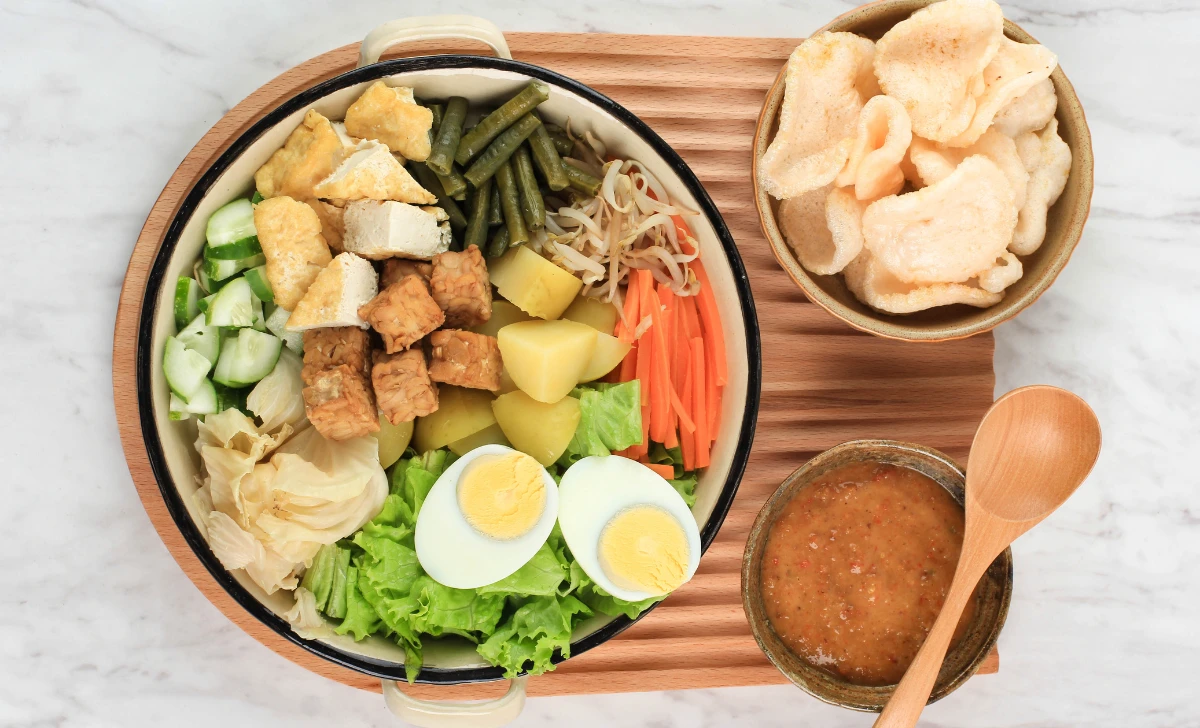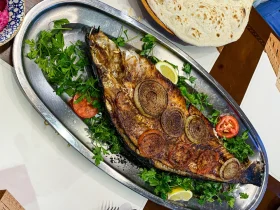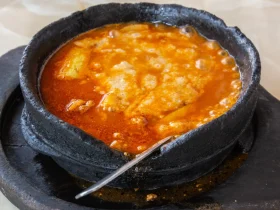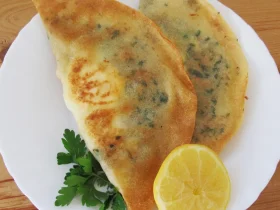Are you ready to embark on a culinary adventure that will tantalize your taste buds? Look no further than the delectable world of Gado-Gado, an Indonesian dish that brings together an array of vibrant flavors and textures into one harmonious ensemble. In this article, we’ll dive into the heart of this mouthwatering recipe, exploring its rich history, the art of crafting the perfect Gado-Gado, and tips to elevate your culinary skills. Whether you’re a seasoned chef or a kitchen newbie, get ready to discover the magic of Gado-Gado!
[ez-toc]
History
To truly appreciate Gado-Gado, we must travel back in time to explore its historical tapestry. This dish’s origins are interwoven with Indonesia’s diverse cultures and culinary traditions. While the exact date of Gado-Gado’s inception remains shrouded in the mists of time, its evolution can be traced through generations of Indonesian cooks who have added their unique twists.
The concept of mixing assorted ingredients to create a satisfying meal was a practice that gained popularity due to Indonesia’s vibrant spice trade history. As merchants and traders traversed the archipelago, they brought with them an array of flavors, including peanuts, spices, and vegetables. These elements soon found their way into the kitchens of Indonesia, contributing to the birth of Gado-Gado.
Culinary Confluence and Cultural Exchange
Gado-Gado’s evolution was not confined to the kitchens alone; it was also a result of cultural exchange and culinary confluence. The dish’s versatility allowed it to adapt to regional tastes and ingredients. As Indonesian communities from various islands interacted and shared their culinary traditions, Gado-Gado transformed into a canvas for creativity.
In the bustling markets of Indonesia, Gado-Gado became a quintessential street food – a quick, satisfying, and flavorful meal that catered to the masses. Over time, Gado-Gado found its way into homes, restaurants, and even formal gatherings, becoming a symbol of Indonesia’s culinary heritage.
Preserving Tradition in the Modern Era
In the present day, Gado-Gado continues to enchant both locals and international food enthusiasts alike. While modern interpretations might incorporate contemporary ingredients or innovative presentation, the heart of Gado-Gado remains true to its origins – a celebration of diversity, harmony, and the joy of mixing flavors.
Time
| Step | Time Required |
|---|---|
| Preparation of ingredients | 20 minutes |
| Blanching vegetables | 15 minutes |
| Preparing protein components | 20 minutes |
| Crafting the peanut sauce | 10 minutes |
| Tofu and tempeh marination and frying | 25 minutes |
| Boiling eggs | 12 minutes |
| Assembling Gado-Gado bowl | 10 minutes |
| Making sambal | 5 minutes |
| Garnishing with krupuk | 2 minutes |
| Overall cooking and preparation time | Approximately 1.5 hours |
Please note that these times are approximate and can vary based on individual cooking skills and kitchen setup. It’s always a good idea to allocate a little extra time, especially if you’re trying the recipe for the first time or if you want to savor the process.
Ingredients
| Ingredients | Quantity for 2 Persons |
|---|---|
| Cabbage | 1 cup, shredded |
| Beansprouts | 1 cup |
| Carrots | 1 medium, julienned |
| Tofu | 150g, cubed |
| Tempeh | 150g, cubed |
| Eggs | 2, boiled and halved |
| Krupuk (Prawn Crackers) | Handful |
| Peanut Sauce Ingredients: | |
| Peanuts | 1/2 cup, roasted |
| Palm Sugar | 2 tablespoons |
| Tamarind Paste | 1 tablespoon |
| Garlic | 2 cloves |
| Shallot | 1 small |
| Bird’s Eye Chili (optional) | 1, minced (adjust to taste) |
| Salt | To taste |
| Water | 1/2 cup |
| Cooking Oil | For frying |
| Lime wedges | For serving |
Please adjust the quantities based on your personal preferences and dietary needs. Enjoy your cooking!
Directions
Step 1: Preparation of Ingredients
- Shred cabbage, julienne the carrots, and gather fresh beansprouts.
- Cube the tofu and tempeh for protein-packed goodness.
- Boil the eggs until they’re perfectly done, then halve them.
Step 2: Blanching Vegetables
- In a pot of boiling water, blanch the cabbage, carrots, and beansprouts separately for about 1-2 minutes each until they’re slightly tender.
- Transfer the blanched vegetables to an ice bath to preserve their vibrant colors and crunchiness.
Step 3: Preparing Protein Components
- Marinate the cubed tofu and tempeh in your favorite marinade for about 15 minutes.
- Heat some cooking oil in a pan and pan-fry the marinated tofu and tempeh until they’re golden and crispy. Set aside.
Step 4: Crafting the Peanut Sauce
- Blend roasted peanuts, palm sugar, tamarind paste, garlic, shallot, and a touch of water until you achieve a creamy consistency.
- Season with a pinch of salt and add minced bird’s eye chili for a spicy kick if desired.
Step 5: Tantalizing Tofu and Tempeh Toppings
- Pan-fry the marinated tofu and tempeh until they’re golden and crispy on all sides. Set aside.
Step 6: Boiled Eggs – A Gado-Gado Staple
- Boil the eggs to your desired level of doneness, then peel and halve them.
Step 7: Assembling Your Gado-Gado Bowl
- Begin by arranging a bed of blanched cabbage, carrots, and beansprouts in a serving bowl.
- Add the pan-fried tofu and tempeh on top.
- Place the halved eggs alongside.
Step 8: Drizzling Peanut Sauce and Garnishing
- Generously drizzle the luscious peanut sauce over the assembled ingredients.
- Garnish your Gado-Gado with a handful of crispy krupuk.
Step 9: Adding Final Touches
- Serve your Gado-Gado with a side of fresh lime wedges for that extra zing.
- Don’t forget to savor the medley of flavors and textures in each bite!
Step 10: Savoring Your Culinary Creation
- With everything beautifully assembled, it’s time to indulge in the masterpiece you’ve created. Mix the ingredients, allowing the peanut sauce to coat each component, and experience the explosion of flavors that is Gado-Gado.
Equipment Required
Nutrition Information
| Nutrition Information | Per 2-Person Serving |
|---|---|
| Serving Size | 1 bowl |
| Calories | ~400 calories |
| Total Fat | ~20g |
| – Saturated Fat | ~4g |
| Cholesterol | ~180mg |
| Sodium | ~700mg |
| Total Carbohydrates | ~40g |
| – Dietary Fiber | ~8g |
| – Sugars | ~10g |
| Protein | ~20g |
Please note that these values are approximate and can vary based on factors such as the specific ingredients and quantities used. It’s always a good practice to calculate the nutritional content based on the specific brands and quantities of ingredients you use.
Tips
- Veggie Variety: While cabbage, beansprouts, and carrots are traditional choices, feel free to experiment with other veggies like cucumber, bell peppers, or even blanched broccoli for added color and nutrients.
- Protein Play: If tofu and tempeh aren’t your favorites, consider using grilled chicken, shrimp, or even pan-fried fish as protein alternatives.
- Peanut Passion: Adjust the peanut sauce’s sweetness, tanginess, or spiciness by experimenting with the palm sugar, tamarind paste, and chili quantities. Taste as you go and find your perfect balance.
- Creamy Coconut Twist: For a unique twist, blend some coconut milk into your peanut sauce. This variation, known as “Gado-Gado Padang,” offers a lush, coconutty dimension.
- Blanching Brilliance: Maintain the vibrant colors and crunch of your blanched veggies by not overcooking them. A quick blanch followed by an ice bath helps retain their freshness.
- Egg Expertise: Boil your eggs to your preferred level of doneness – from slightly runny yolks to hard-boiled. Remember that eggs continue to cook a bit even after boiling, so adjust cooking time accordingly.
- Artful Arrangement: Take your time when assembling your Gado-Gado bowl. Arrange the components in a visually appealing manner – after all, we eat with our eyes first!
- Sambal Sensation: If you’re a spice enthusiast, consider preparing different variations of sambal to accompany your Gado-Gado. Tomato-based sambal or even a pineapple chili sambal can add a burst of heat and flavor.
- Nut Allergies: If you or your guests have nut allergies, you can create a similar sauce using sunflower seeds or roasted chickpeas instead of peanuts.
- Leftover Love: Got some leftover Gado-Gado components? Transform them into wraps or sandwiches with a drizzle of peanut sauce for a quick and satisfying meal.
- Texture Temptation: For an extra layer of crunch, add fried shallots, crushed peanuts, or even pomegranate seeds as a topping.
- Balance is Key: Gado-Gado is all about balance – between textures, flavors, and even temperatures. The combination of warm protein and blanched veggies with the cool peanut sauce creates a delightful contrast.
- Party Pleaser: Hosting a gathering? Serve Gado-Gado in a buffet-style setup, allowing guests to customize their bowls with their preferred components and toppings.
- Be Fearless: Gado-Gado is forgiving and welcomes culinary exploration. Don’t hesitate to try new combinations and flavors – that’s how culinary masterpieces are born!
Pros & Cons
| Pros | Cons |
|---|---|
| ✅ Bursting with flavors and textures | ❌ Time-consuming preparation |
| ✅ Offers a balanced, nutritious meal | ❌ Requires multiple components |
| ✅ Customizable with various veggies and proteins | ❌ Peanut allergy concerns |
| ✅ Reflects Indonesia’s rich culinary heritage | ❌ Some ingredients might be hard to find |
| ✅ Great for gatherings and impressing guests | ❌ Spiciness might not suit all palates |
Conclusion
As we conclude our flavorful journey through the world of Gado-Gado, we invite you to step into your kitchen with newfound excitement. Gado-Gado isn’t just a recipe; it’s an invitation to explore the harmonious blend of textures, the dance of flavors, and the cultural tapestry that Indonesia has woven into each bite.
From the moment you blanch the vegetables to the final drizzle of peanut sauce, every step of creating Gado-Gado is an opportunity to infuse your own creative spirit. Whether you’re seeking a nutritious meal, a captivating culinary experience, or a chance to connect with Indonesian heritage, Gado-Gado delivers on all fronts.
Remember that cooking is an adventure, and Gado-Gado is your ticket to embark on an unforgettable journey. Embrace the medley of ingredients, the aromatic spices, and the joy of crafting a dish that not only delights your palate but also reflects the rich tapestry of Indonesian culture.
So, don your apron, gather your ingredients, and allow your kitchen to transform into a canvas of flavors. With every blanched vegetable, every crispy protein, and every luscious drizzle of peanut sauce, you’re creating more than a meal – you’re creating memories that will linger on your taste buds and in your heart.
Gado-Gado beckons you to break free from the ordinary, to savor the extraordinary, and to embrace the culinary magic that happens when diverse ingredients come together. It’s more than a recipe; it’s an experience waiting to be savored. Now, armed with knowledge, tips, and a sprinkle of creativity, it’s time to embark on your own Gado-Gado adventure. Happy cooking and bon appétit! 🍽️🌶️🥬
Facts
- 🌍 Fact 1: A Taste of Cultural Fusion 🌍
- Did you know that Gado-Gado is a culinary masterpiece born from a fusion of cultures? This delectable dish captures the essence of Indonesia’s diverse history and trade routes. Just like the spices that traveled along ancient trade routes, Gado-Gado brings together a medley of flavors and ingredients in a harmonious blend that reflects Indonesia’s rich cultural tapestry.
- 🥜 Fact 2: The Nutty Evolution of Peanut Sauce 🥜
- Peanut sauce, the luscious star of Gado-Gado, has a flavorful evolution. Originating from Java, this sauce has traversed through time and tastes, transforming from a simple peanut paste to a complex blend of peanuts, tamarind, and spices. It’s not just a sauce; it’s a journey through culinary history that tickles your taste buds.
- 🛡️ Fact 3: Gado-Gado – A Symbol of Resilience 🛡️
- Gado-Gado is more than just a dish; it’s a symbol of resilience. In times of scarcity, Indonesians turned to Gado-Gado as a nutritious and flavorful solution. The dish’s adaptability allowed families to create a satisfying meal using whatever ingredients were on hand. It’s a reminder that creativity in the kitchen can lead to mouthwatering results.
- 🍃 Fact 4: Veggie-Packed Gado-Gado Gardens 🍃
- Ever heard of “Gado-Gado Gardens”? These vibrant plots in Indonesia showcase an array of veggies and herbs used in Gado-Gado. Imagine strolling through rows of fresh beansprouts, crisp cabbage, and fragrant shallots, all destined for the masterpiece that is Gado-Gado. It’s like a garden of flavors ready to be mixed and matched on your plate.
- 🎉 Fact 5: Gado-Gado – A Celebration Dish 🎉
- Gado-Gado isn’t just about food; it’s about celebration. In Indonesia, Gado-Gado often graces the tables of special occasions, from weddings to festivals. The medley of colors and flavors mirrors the festive spirit of these gatherings. So, the next time you enjoy Gado-Gado, remember that you’re savoring a dish that’s synonymous with joy and jubilation.
FAQ’s
Can I make Gado-Gado with only vegetarian ingredients?
Absolutely! Gado-Gado is highly customizable. You can stick to veggies, tofu, and tempeh for a delicious vegetarian version.
What’s the role of tamarind paste in the peanut sauce?
Tamarind paste adds a tangy depth to the peanut sauce, balancing out the richness and enhancing the overall flavor profile.
Can I use store-bought peanut butter instead of grinding peanuts?
While fresh ground peanuts yield the best flavor, natural peanut butter without added sugar or oil can be a convenient alternative.
Is Gado-Gado suitable for people with nut allergies?
If you have nut allergies, consider using sunflower seeds or roasted chickpeas as a base for the sauce. Always check ingredient labels.
Can I prepare Gado-Gado in advance for a party?
Yes, you can blanch the veggies, cook the protein, and make the sauce ahead of time. Assemble just before serving to maintain freshness.
What’s the best way to store leftover Gado-Gado?
Store components separately in airtight containers in the fridge. Reheat protein and blanched veggies gently before assembling.
Can I skip the spicy chili in the peanut sauce?
Absolutely. Omitting the chili won’t significantly impact the flavor. Adjust the other seasonings to your taste preference.
Are there any gluten-free alternatives for the crispy krupuk garnish?
Look for gluten-free krupuk options or skip them altogether. Alternatively, toasted rice crackers can provide a similar crunch.
Can I use other sauces apart from peanut sauce with Gado-Gado?
Traditional peanut sauce is iconic, but feel free to experiment with sesame-based dressings, tahini, or coconut milk-based sauces.
Can I add additional proteins like grilled chicken or shrimp to Gado-Gado?
Absolutely! Gado-Gado’s versatility allows you to experiment with various proteins like grilled chicken, shrimp, or even fish to suit your tastes.












Leave a Review